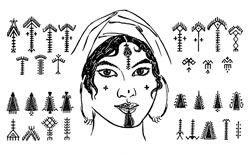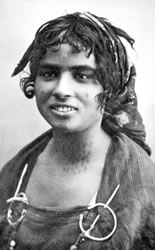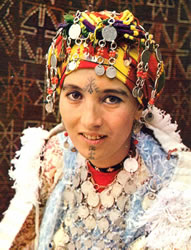Tattooing in North Africa, The Middle East and Balkans
Article © 2010 Lars Krutak
Among the Kabyle, women, as mothers and guardians of the family, were obliged to perform “all the tasks concerned with protecting things that grow and shoot [up], that are green and tender. It [was] a women’s duty to watch over the growth of the young [children] and young animals.” But they were also seen as a social danger being susceptible to the machinations of evil spirits (jnoun) who could steal the life of their children as easily as that of their husbands. According to Islamic tradition, Moroccan women were especially susceptible to the malevolence brought by jnoun who infested the landscape:
whole tribes of jnoun are waiting to be inflamed by the smell of [menstrual]
blood, they become irritated by scalding water in the household and that in the hammam or bathing house; they are made jealous by the sight of a pretty baby; Et Tabi'a, "The Pursuer" and Queen of the jnoun hangs around to make women abort; Lalla Kandicha [an evil spirit] is waiting to bewitch her husband.
But jnoun did have their weaknesses and were susceptible to the baraka that was embodied in specific types of tattoos, pricked upon the skin of women in differing patterns. Legey wrote that tattooing “combated a woman’s evil fate” and was part of a complex of anti-sterility rites to induce pregnancy. Michaux-Bellaire and Salmon stated that in north Morocco if a child died in the family, subsequent youths were tattooed with two little lines on the side of the nose called l-‘ayyacha (“that which gives life”). Herber and Westermarck also discussed the protective power of l-‘ayyacha and Blackman alludes to it in her study of tattooed fellahin villagers and farmers in Egypt. Searight, discussing the account of an American woman in Morocco in the 1960s, attributed that elements of the tattoo’s baraka were embodied in the tattooist’s spittle: |
|
She was staying with an Arab woman in Meknes who was heavily pregnant.
The expected day of birth passed, and nothing happened. A few weeks later she
returned to the house to find a stranger on her knees beside her friend, scraping
black off the bottom of a pot; she spat on it, rubbed the back of the ankle of the
pregnant woman and tattooed a cross with a needle 'to drive away the evil that
was preventing her from giving birth.'
In another reference, Searight witnessed a female tattooist working in Rabat who spat on the tattoo "because her spittle had baraka and the tattoo would not get infected."
|

Tunisian Berber facial tattoos, ca. 1920. "Palm tree" motifs (nahla), often in the form of chin markings (siyâla), were thought to induce fertility. The origin of the symbol is identified with the ancient Carthagenian goddess Tanit.
|
It has been widely documented that jnoun disliked sharp objects, Westermarck noted that iron daggers, swords and needles were often used at weddings as safeguards against jnoun. Iron objects such as these, and others including ploughshares, sickles, and carding combs, were believed to dispel malevolent entities because of their symbolic association with the blacksmith, the master of fire. Iron tools made or associated with fire, iron objects which were used to cut and sever (especially the throats of sacrificial animals, and of men), to pierce and tattoo, to burn, bleed and circumcise, were all products of the work of the blacksmith and used in virilization and prophylactic rites intended to ward off disease and illness associated with jnoun. Thus, the Kabyle rites of circumcision and tree pruning, like tattooing and ritual bleeding, operated on the level of purification in which the iron instruments used to carry out these rituals, each forged from fire, had a beneficent function. Similarly during the Kabyle summer solstice (insla), purifying fires were lit in the house, among the flocks of sheep, in the orchards, by the beehives, on the threshing floor, and among other places, to cleanse, sterilize, and prepare the community for the coming of summer: a time regarded as unpropitious for any act of procreation, and hence for weddings, but a propitious period when purificatory tattooing, scarification, piercing and bleeding are performed on men and animals.

|
 |
(Far left) Tunisian Berber woman with neck and facial tattooing, ca. 1920. Postcard from the collection of the author.
Tattooed Berber woman from the Atlas Mountains, Morocco. |
Within the complex of tattoo designs, the role of particular motifs – like crosses – or especially others with pointy or finger-like protuberances, were magical and believed to have the power to pierce the evil eye. Westermarck recorded that Berber women in many regions of Morocco wore small crosses on their faces and the tips of their noses. He also noted “a man whose nose was thus decorated with a cross. [He] told me that the tattooing had been done in his infancy because his two elder brothers had died shortly after birth, and that was one of the methods prevalent in his tribe of preserving the life of a child if the previous children had died; but the same charm may in similar circumstances be tattooed underneath the lip instead [or on the] forefinger of the right hand.” Westermarck, however, believed that such cruciform elements had a deeper meaning, one related to the idea that the symbol seems “to disperse the evil energy emanating from the eye to all [four] quarters of the wind in order to prevent it from injuring the person or object looked at,” a belief common to indigenous peoples from North Africa to the Punjab of India. Of course, the cross as a tattoo symbol predates the era of Christianity and can be seen not only as a form of body adornment among ancient Libyans represented on Egyptian monuments, but also on the five-thousand year old skin of the Iceman mummy whose tattoos were likely therapeutic.
In North Africa, the human hand, called khamsa – a symbol of human creative activity, power and dominance – also had magical properties believed to defend individuals from the evil eye and jnoun alike. Representing the protective hand of Fatima, daughter of the Prophet Mohammad, khamsa takes many forms, especially in tattoo or jewelry, and can be depicted in realistic or abstract fashion with its fingers open, spread, or joined. Oftentimes it is painted on the backs of trucks or seen dangling from rear-view mirrors in cars, not to mention being painted on the gates of houses. In Tunisia, various abstract renderings of horns or fingerlike projections were tattooed on the backs of hands to “double” their protective potential.
Next Page | 1
|
2 |
3 |
4 |
5 |
6 |
7 |
8 |
Museum photo gallery of the images
on this page may be seen here. |



